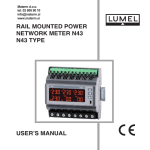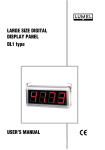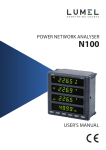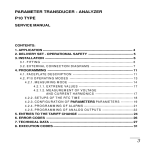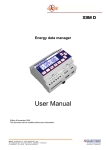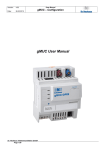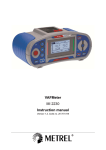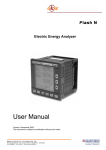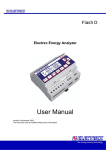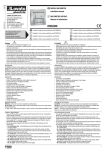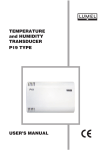Download N43 TYPE USER`S MANUAL
Transcript
RAIL MOUNTED POWER NETWORK METER N43 N43 TYPE USER’S MANUAL 1 CONTENTS 1. Application................................................................................... 5 2. meter set...................................................................................... 6 3. BASIC REQUIREMENTS, OPERATIONAL SAFETY...................... 6 4. INSTALLATION................................................................................. 7 5. METER DESCRIPTION.................................................................... 8 6. N43 PROGRAMMING..................................................................... 13 7. SOFTWARE UPGRADES............................................................... 34 8. SERIAL INTERFACES.................................................................... 36 9. ERROR CODES.............................................................................. 57 10. ACCESSORIES ........................................................................... 58 11. TECHNICAL DATA........................................................................ 58 12. ORDERING CODE........................................................................ 63 1. APPLICATION The N43 meter,assembled on a rail, is a programmable digital instrument designed for the measurement of 3-phase, 3 or 4-wire power network parameters in balanced or unbalanced systems. The measured values are displayed on a dedicated LCD display. The meter enables control and optimization of the power electronic devices, systems and industrial installations. The meter can be used for measuring: RMS of voltage and current, active, reactive and apparent power, active and reactive energy, power factors, frequency,THD and averaged values P Demand - „power guard”, S Demand, I Demand /15, 30 or 60 minutes/. Voltages and currents are multiplied by given voltage and current ratios of the measuring transformers /for indirect connections/. Power and energy indications take into account all programmed ratio values. The value of each measured value can be transmitted to the master system via the RS-485 interface. Three relay outputs signal the overflow of the chosen quantity, and the pulse output can be used for the consumption check of 3-phase active energy. There is a galvanic separation between following units of the meter: - supply, - voltage and current inputs, - RS-485 and USB outputs, - pulse output. 2. METER SET Complete set of the meter includes: - N43 Meter............................... 1 pc - user’s manual.......................... 1 pc - warranty card.......................... 1 pc - CD........................................... 1 pc 3. Basic requirements, operational safety In terms of operational safety it meets the requirements of the EN 61010-1 standard. Comments concerning safety: • The meter should be installed and connected only by a qualified personnel. All relevant safety measures should be observed during installation. • Always check the connections before turning the meter on. • Prior to taking the meter housing off, always turn the supply off and disconnect the measuring circuits. • Removal of the meter housing during the warranty period voids the warranty. • This meter conforms to all requirements of the electromagnetic compatibility in the industrial environment. • The building installation should have a switch or a circuit-breaker installed. This switch should be located near the device, easy accessible by the operator and suitably marked. 4. Installation The meter is designed for installation in modular distribution boards on a 35 mm rail. The meter housing is made of plastic. Housing dimensions: 105 x 110 x 60 mm. There are screw terminal strips on the outer side of the meter which enable the connection of external wires with diameter up to 5.3 mm2 /indirect measurement/ and up to 16 mm2 /direct measurement/. The meters should not be installed on the rail in direct contact with other devices that emit heat (e.g. other N43 meters). There must be a minimum 5 mm spacing between devices in order to enable heat transfer from a housing to the environment. Otherwise, the ambient temperature of a meter working in direct contact with other devices can exceed the operating temperature specified in rated operating conditions. Fig. 1. Meter dimensions 5. Meter description 5.1 Current inputs All current inputs are galvanically isolated (internal current transformers). The meter is adapted for direct connections /up to 63 A/ or to work with external measuring current transformers /version 1 A/5 A /. Displayed current values and derivative quantities are automatically converted in relation to the introduced external current transformer ratio. 5.2 Voltage inputs Quantities on voltage inputs are automatically converted acc. to the introduced ratio of the external voltage transformer. Voltage inputs are specified in the order as either 3 x 57.7/100 V, 3 x 230/400 V or 3 x 290/500 V. 5.3 Connection diagrams a) Meter connection diagrams in the 3-phase 4-wire network Direct measurement in 4-wire network Semi-indirect measurement in 4-wire network 10 Indirect measurement with the use of 3 current transformers and 2 or 3 voltage transformers in a 4-wire network Semi-indirect measurement in a 3-wire network b) Meter connection diagrams in the 3-phase 3-wire network 11 Fig 2. Meter connection diagrams in a network: a) 3-phase 4-wire, b) 3-phase 3-wire 12 Direct measurement with the use of 2 current transformers and 2 or 3 voltage transformers in a 3-wire network 6. N43 Programming 6.1 Front panel Fig. 3. Front panel Front panel description: increase value button and right displacement active energy export decrease value button and left displacement active energy import confirm button (ENTER) symbol of energy / reactive inductive power USB socket symbol of energy / reactive capacity power f1...f6 6 field 3-digit displays for readout and setting, fields f5 and f6 can create one 7-digit field symbol of pulse output * units of the displayed values symbols of alarms activation indication phase kilo = 103 of displayed Mega = 106 13 6.2 Power-on messages Fig. 4. Message after starting the meter After switching the supply on, the meter performs a display test and displays the N43 meter name, build and current software as well as bootloader version. where: n43 – meter type, 5A 230V – version rEu revision 0.10 program version number b0.00 bootloader version number 14 6.3 Operating modes Switching a supply on Display of maximum, minimum value -erasing or 3 sec. MEASURE mode Change of displayed pages Erasing of alarm latch 3 sec. Enter a code or Code Selection of Set parameters Meter parameters mode Parameters acc. to Table 3 dEf=YES default settings or Change of quantity of a selected parameter or Output parameters mode Parameters acc. to Table 7 dEf=YES default settings or Change of quantity of a selected parameter or Alarm parameters mode Parameters acc. to Table 4 dEf=YES default settings or Pages configuration mode Selection of pages PAGn dEf=YES default settings Change of quantity of a selected parameter or or Selection of parameter on a page or means: >15 sec. or simultaneous pressure of the buttons Fig. 5. N43 meter operating modes 15 6.4 Tryb POMIAR In Measure mode the values are displayed according to the pages that are preset at the factory or configured by the user in Pages Programming PAG. Changing the page is done by pressing the or . The sequence of displayed pages is according to a table created in PAG mode. Entry into monitoring of maximum and minimum values mode occurs when pressing at the same time the buttons and for at least 3 seconds. Erasing maximum and minimum values is done by pressing the button while monitoring their value.Alarms are active if they were allocated. Note that the alarms do not need to be associated with quantities displayed on the page because the change of a page would result in action on two-state outputs. Erasing alarm signalization latch / if it was set in the Alarm parameters mode Aln / is done by pressing the buttons . When reactive power/energy is displayed, this indication is accompanied by a symbol of the inductive load or capacity load . When active energy is displayed, this indication is accompanied by a symbol of active energy export or active energy import. 16 Voltage [V] Current [A] Active power [W] Reactive power [Var] Apparent power [VA] Floating point Active energy [Wh] Reactive energy [VArh] Apparent energy [VAh] Fig 6. Formats of displayed values. Exceeding of the upper or lower indication range is signaled on the display by upper horizontal lines. For measurement of the averaged values (P Demand, S Demand, I Demand) single measurements are carried out with one second quantum, however, visualized every 15 seconds. Averaging time to choose from: 15, 30 or 60 minutes. After the meter is turned on or after the averaged values are reset, the first value will be calculated in 15 seconds after turning meter on or resetting. Until all samples of the averaged values are acquired, the values are calculated from already measured samples. Current value in the neutral wire I(N) calculated from phase current vectors is available in the registry 7544 of the serial interface. The alarm switching on is signaled by the lighting of the Aln inscription (n= 1..3). The end of alarm duration at the alarm signalization latch switched on, is indicated by the pulsation of the Aln inscription (n= 1..3). 17 Selection of the monitored value: 3Ph / 3W Available display fields √ x f1 (k)A L1 √ √ f1 P1 (M,k)W L1 √ x f1 q1 (M,k)VAr L1 √ x f1 S1 (M,k)VA L1 √ x f1 phase active power 06 L1 factor (PF1=P1/S1) PF1 PF L1 √ x f1 factor of L1 phase 07 tgj (tg1=Q1/P1) t61 tg L1 √ x f1 08 L1 phase voltage THD THDU1 V% L1 √ x f1 09 L1 phase current THD THDI1 A% L1 √ x f1 10 L2 phase voltage U2 (k)V L2 √ x f2 11 L2 phase wire current I2 (k)A L2 √ √ f2 12 L2 phase active power P2 L2 √ x f2 13 L2 phase reactive power q2 (M,k)W (M,k)VAr L2 √ X f2 14 L2 phase apparent power S2 (M,k)VA L2 √ X f2 phase active power 15 L2 factor (PF2=P2/S2) PF2 PF L2 √ X f2 quantity - blanked 00 no display oFF 01 L1 phase voltage U1 (k)V 02 L1 phase wire current I1 03 L1 phase active power phase reactive 04 L1 power phase apparent 05 L1 power Signaling L1 Unit f1,f2,f3,f4,f5,f6 Marking √ Quantity name √ No. of par. 3Ph / 4W Table 1 factor of L2 phase t62 16 tgj (tg2=Q2/P2) 17 L2 phase voltage THD THDU2 18 L2 phase current THD THDI2 tg L2 √ X f2 V% A% L2 L2 √ √ X X f2 f2 19 L3 phase voltage (k)V L3 √ X f3 18 U3 20 L3 phase wire current I3 (k)A L3 √ √ f3 21 L3 phase active power P3 (M,k)W L3 √ X f3 22 L3 phase reactive power Q3 (M,k)VAr L3 √ X f3 23 L3 phase apparent power S3 (M,k)VA L3 √ X f3 PF L3 √ X f3 phase active power PF3 24 L3 factor (PF3=P3/S3) factor of L3 phase t63 25 tgj (tg3=Q3/P3) 26 L3 phase voltage THD THDU3 27 L3 phase current THD THDI3 tg L3 √ X f3 V% A% L3 L3 √ √ X X f3 f3 28 3-phase mean current* IS (k)A SL √ √ f1,f2,f3,f4,f5 29 3-phase active power 30 3-phase reactive power P q (M,k)W (M,k)VAr SL SL √ √ √ √ f1,f2,f3,f4,f6 f1,f2,f3,f4,f6 31 3-phase apparent power active power 32 3-phase factor (PF=P/S) factor 3 phases 33 tgj mean (tg=Q/P) 34 Frequency voltage 35 phase-to-phase L1-L2 Phase-to-phase voltage 36 L2-L3 Phase-to-phase voltage 37 L3-L1 Mean phase-to-phase 38 voltage * Active power averaged 39 (P Demand )* Reactive power avera40 ged (S Demand )* Current averaged 41 (I Demand) * Active 3-phase input 42 energy Active 3-phase output 43 energy 44 Reactive 3-phase inductive energy S (M,k)VA SL √ √ f1,f2,f3,f4,f5 PF PF SL √ √ f1,f2,f3,f4 tG tg SL √ √ f1,f2,f3,f4 F F SL √ √ f4 U12 (k)V L1 L2 √ √ f1 U23 (k)V L2 L3 √ √ f2 U31 (k)V L3 L1 √ √ f3 U123 (k)V SL √ √ f1,f2,f3,f4,f5 Pdt (M,k)W √ √ f4 Sdt (M,k)VA SL DM SL DM √ √ f4 Idt (k)A SL DM √ √ f4 EnP (M,k)Wh SL √ √ f5-f6 EnP (M,k)Wh SL √ √ f5-f6 EnQ (M,k)VArh SL √ √ f5-f6 19 45 Reactive 3-phase capacity energy EnQ (M,k)VArh 46 3-phase apparent energy EnS (M,k)VAh 47 Time – hours, minutes, seconds hour SL √ √ f5-f6 SL √ √ f5-f6 √ √ f5-f6 * available minimum and maximum values on the display and interface registers 6.5 Parameter Settings Fig 7. Setup menu Programming mode is enabled by pressing and holding button for about 3 seconds. To enable the programming user must enter a correct access code. If there is no such a code or after entering a correct code the program transits into the programming option. The message SET (in the first field) and first parameter group PAr are displayed. 20 If the wrong access code is entered, only monitoring of the parameters is possible without possibility of changing them. Err cod is displayed and then rE Ad Par. Free eCon software can also be used for configuration of the N43 meters, it is available on the website www.lumel.com.pl. Fig. 8. Programming matrix 21 6.5.1 Setting of Meter Parameters Range Notes/ description Manufacturer value 1 Access code entry Marking Item Parameter name After entering the SEt procedure select with the button or mode Par and press . Buttons set the requested values. The active position is signaled by the cursor. The set value can be accepted by the button . Exit from the SEt procedure follows after pressing simultaneously the buttons or waiting approx. 15 seconds. Table 2 SEc 0..30000 0 – no code 0 3LN 5 2 Type of connection con 3PH-4 3PH-3 3PH-4 – 3-phase, 4-wire 3PH-3 – 3-phase, 3-wire 3 Input current range rn1 1A, 5A or 63A Input range: 1A or 5A (for version In 1A/5A) or 63A (for version In 63A) 4 Current ratio transformer trI 1 .. 10000 1 5 Voltage ratio transformer trU 0,1…4000,0 1,0 Averaging time /Demand integration 6 time/ 22 dIt t_15, t_30, t_60 Averaging time of active power P Demand, apparent power S Demand, current I Demand t_15, t_30, t_60 15 Averaging synchro7 nization with the real-time clock 8 Energy counters erasing En0 9 Erasing averaged parameters au0 10 Default settings on/oFF syn dEf no – no activity, En P – erase active energy, no,En P, En q, En q – erase reactive En S, energy, En ALL En S – erase apparent energy, En ALL – erase all energies no, yES Y n Yes/no n reverting to default (factory) group settings Par n The automatic erasing of the energy is done with a change of voltage or current ratio. During the acceptation the value insertion possibility in the range is checked. If the set value falls outside the allowable range, the meter remains in parameter setting mode and the value is set to the highest possible value (when entered value is too high) or lowest possible value (when it is too low). 23 6.5.2 Setting of Output Parameters Range Notes/ description Manufacturer value Number of impulses of OC output MODBUS Network 2 Address 1 Designation Parameter name Item In the options, select the oUt mode and confirm your choice by pressing the button . Table 3 Ion 100 ..20000 number of impulses/ 1kWh 1000 Adr 1…247 1 r8n2, r8E1, r8o1, r8n1 4.8 k, 9.6 k, 19.2 k, 38.4 k 3 Transmission mode trb 4 Baud rate bAu 5 Hour, minute t_H 0,00.. 23,59 6 Default settings dEf no, yES 8n2 9.6 k 00.00 reverting to default (factory) group settings Par n 24 Notes/ description Manufacturer value 2 Alarm type Range Quantity on the alarm output Designation 1 Parameter name Item 6.5.3 Setting of alarm parameters In the options select the ALn mode and confirm your choice by pressing the button Table 4 A_n 0..42 code as in Tab. 5 A_t n-on, n-oFF, on,oFF, H-on, H-oFF, AL1=U123 AL2=IS AL3=P Fig. 9 n-on 3 Lower value of the input range AoF -144.0…144.0 in % of the rated quantity value 90.0 4 Upper value of the input range Aon -144.0…144.0 in % of the rated quantity value 110.0 Atn 0 … 3600 in seconds 0 6 Time delay of the Atf switch off reaction 0 … 3600 in seconds 0 7 Alarm re-activation lock 0 … 3600 in seconds 0 on, oFF When alarm signalization latch function is enabled and the alarm state ends, alarm symbol is not turned off but begins to flash. Alarm symbol flashes until it is turned off by pressing the buttons oFF Time delay of 5 the switch on reaction 8 Alarm signalization latch A_b A_S (> 3 sec). This function refers only to the alarm signalization, so the relay contacts will operate without a latch according to the selected alarm type. 9 Default settings dEF no, yES restoring default (factory) group settings PAr no 25 Entering the value Aon lower than AoF switches the alarm off. a) n-on b) n-oFF c) On d) OFF 26 Fig. 9. Alarm types: a)n-on, b) n-oFF c) On, d) OFF. Remaining types of the alarm: • H-on – always enabled; • H-oFF – always disabled. Example no 1 of alarm setting: Set alarm n-on type for monitored quantity P – 3-phase active power, Version: 5 A; 3 x 230/400 V. Setting the alarm on after exceeding 3800 W, switching the alarm off after power drops to 3100 W. Calculations: rated 3-phase active power: P = 3 x 230 V x 5 A = 3450 W 3450 W – 100 % 3450 W – 100 % 3800 W – Aon % 3100 W – AoF % In conclusion: Aon = 110.0 % AoF = 90.0 % Set: Monitored quantity: P; Rodzaj alarmu: n-on, Aon 110.0, AoF 90.0. 27 Selection of quantities on the alarm outputs: Table 5 Item/ value in the register 4014, 4022, 4030 Displayed element 00 oFF no quantity /alarm disabled/ 01 U_1 L1 phase voltage Un [V] * 02 I_1 L1 phase wire current In [A] * 03 P_1 L1 phase active power Un x In x cos(0°) [W] * 04 q_1 L1 phase reactive power Un x In x sin(90°) [Var] * 05 S_1 L1 phase apparent power Un x In [VA] * 06 PF1 L1 phase power factor (PF) tg1 tgj factor of L1 phase 07 28 Quantity type Value needed for calculations of percentage of the alarm values (100 %) none 1 1 08 THDU1 L1 phase voltage THD 100,00% 09 THDI1 L1 phase current THD 100,00% 10 U_2 L2 phase voltage Un [V] * 11 I_2 L2 phase wire current In [A] * 12 P_2 L2 phase active power 13 q_2 L2 phase reactive power Un x In x sin(90°) [Var] * 14 S_2 L2 phase apparent power Un x In [VA] * 15 PF2 L2 phase power factor (PF) 1 16 tg2 tgj factor of L2 phase 1 Un x In x cos(0°) [W] * 17 THDU2 L2 phase voltage THD 100.00% 18 THDI2 L2 phase current THD 100.00% 19 U_3 L3 phase voltage Un [V] * 20 I_3 L3 phase wire current In [A] * 21 P_3 L3 phase active power Un x In x cos(0°) [W] * 22 q_3 L3 phase reactive power Un x In x sin(90°) [Var] * 23 S_3 L3 phase apparent power Un x In [VA] * 24 PF3 L3 phase power factor (PF) 1 25 tg3 tgj factor of L3 phase 1 26 THDU3 L3 phase voltage THD 100.00% 27 THDI3 L3 phase current THD 100.00% 28 U_A mean 3-phase voltage Un [V] * 29 I_A mean 3-phase current In [A] * 30 P 31 q 3-phase active power (P1+P2+P3) 3-phase reactive power (Q1+Q2+Q3) 3-phase apparent power (S1+S2+S3) 3 x Un x In x cos(0°) [W] * 3 x Un x In x sin(90°) [Var] * 32 S 33 PF_A 3-phase power factor (PF) 3x Un x In [VA] * 1 34 tg_A tgj factor of 3 phases 1 35 FrEq frequency 36 U12 phase-to-phase voltage L1-L2 √3 Un [V] * 37 U23 phase-to-phase voltage L2-L3 √3 Un [V] * 38 U31 phase-to-phase voltage L3-L1 √3 Un [V] * 39 U123 mean phase-to-phase voltage √3 Un [V] * 100 [Hz] 29 40 Pdt 41 Sdt 42 Idt active power averaged (P Demand )* reactive power averaged (S Demand )* 3 x Un x In x cos(0°) [W] * 3 x Un x In [VA] * current averaged (I Demand) * In [A] * * Un, In - rated values of voltages and currents 6.5.4 Pages configuration mode In the options, select the PAG mode and confirm your choice by pressing the button . Buttons allow to select the page number to edit, to accept press the button . Buttons allow to select the config mode, to accept press the button . The cursor (blinking ---) will move to the first field f1. Buttons allow to select the fields f1-f6. Confirm a field selection by pressing the button . Selection of the monitored value in a selected field can be done by pressing the buttons and confirmed by pressing the button . After setting required quantities in the fields f1-f6 make, confirm it and save the pages with the selected quantities by pressing for (approx. 3 sec.) the button . Fig.10 A display in pages configuration mode. 30 Item Pages programming 1 Parameter Designame nation Display panel illumination lgt Range Table 6 Notes/description Manufacturer value oFF – off, on – on, 1..60 – illumination time oFF,1…60, on (in seconds) from pressing the button on oFF– disabled, on – enabled, config – editing a selected page on 2 Page 1 P01 oFF, on, config 3 Page 2 P02 oFF, on, config 4 Page 3 P03 oFF, on, config 5 Page 4 P04 oFF, on, config 6 Page 5 P05 oFF, on, config 7 Page 6 P06 oFF, on, config 8 Page 7 P07 oFF, on, config oFF– disabled, on – enabled, config – editing a selected page oFF– disabled, on – enabled, config – editing a selected page oFF– disabled, on – enabled, config – editing a selected page oFF– disabled, on – enabled, config – editing a selected page oFF– disabled, on – enabled, config – editing a selected page oFF– disabled, on – enabled, config – editing a selected page on on on on on on 31 9 Page 8 P08 oFF, on, config 10 Page 9 P09 oFF, on, config 11 Page 10 P10 oFF, on, config 12 Page 11 P11 oFF, on, config 13 Page 12 P12 oFF, on, config oFF– disabled, on – enabled, config – editing a selected page oFF– disabled, on – enabled, config – editing a selected page oFF– disabled, on – enabled, config – editing a selected page oFF– disabled, on – enabled, config – editing a selected page strony oFF– disabled, on – enabled, config – editing a selected pagestrony Manufacturer settings are shown below: P02 P01 U1 V U2 V U3 V U12 V U23 V U31 V F q VAr PW U123 V q VAr PW i IA i2 A i3 A P1 W P2 W P3 W iS A q VAr PW PF q VAr PW P2 VAr P3 VAr S1 VA S2 VA s3 VA PW 5 VA P04 P03 P06 P05 q1 VAr t6 32 q VAr EnS kVAh on on on on on P08 P07 PF1 PF2 pf EnP kWh PF3 t61 t62 t6 EnP kWh t63 P10 P09 tHDU1 % f thdu2 % thdU3 % PDm W EnQ kVArh SDM VA Thdi2 % thdi3 EnQ kVArh P12 P11 P W Thdi1 % q VAr EnP kWh S VA P W iDM A q VAr q VA hh.mm.ss Visualization of the manufacturer’s page P02: Fig.11 Visualization of the manufacturer’s page P02 33 7. SOFTWARE UPGRADE A feature implemented in the N43 meters enables to upgrade firmware using a PC with eCon software installed. Free eCon software and the update files are available at www.lumel.com.pl. Updating can be done directly via USB or RS485 interface using RS485 to USB converter, e.g.: PD10 converter. a) b) Fig. 12. Program window view: a) eCon, b) software updates Caution! Software update automatically resets meter settings to manufacturer settings, so it is recommended to save meter settings using eCon software before upgrading. After launching eCon software, set in the settings required serial port, baud rate, mode and address of the meter. Next, select the N43 meter and click Config. Click the down arrow icon to read all of the settings then the disk icon to save the settings to a file (required to restore the settings later). After selecting the 34 option Update firmware (in the upper right corner of the screen) the window Lumel Updater will be opened (LU) – Fig. 12 b. press Connect. The Messages information window displays information concerning upgrade process. If the port is opened correctly, a Port opened message appears. Upgrade mode may be entered using either of the two methods: remotely via LU (using eCon settings – address, mode, baud rate, COM port) and by turning a meter on while pressing the button (while entering bootloader mode using a button, an update is done via USB interface only – baud rate 9600, RTU8N2, address 1). The display will show the bootloader version, while the LU program displays the message Device found and the name and version of the connected device. Click the ... button and browse to the meter upgrade file. If the file is opened correctly, a File opened message is displayed. Press the Send button. When upgrade is successfully completed, the meter begins normal operation while the information window displays Done message and upgrade elapsed time. The next update can only be done via a USB interface in case of a failed upgrade. After the LU window is closed, go to parameter group Restoring manufacturer settings, select the option and press the button Apply. Then press the folder icon to open a previously saved settings file and press the up arrow icon to save the settings in the meter. Current software version can be checked by reading the welcome message when switching the meter on. Caution! Turning meter supply off during upgrade process may result in permanent damage! 35 8. SERIAL INTERFACES 8.1 RS485 INTERFACE – list of parameters The implemented protocol is compliant with the PI-MBUS-300 Rev G specification of Modicon. List of N43 meter serial interface parameters: • identifier 0xCF • meter address 1..247 • baud rate 4.8, 9.6, 19.2, 38.4 kbit/s, • operating mode Modbus RTU, • transmission mode 8N2, 8E1, 8O1, 8N1, • max. response time 600 ms. • max. no. of registers read in a single query - 41 4-byte registers, - 82 2-byte registers, • implemented functions 03, 04, 06, 16, 17, - 03, 04 register readout, - 06 single register writing, - 16 writing of n registers, - 17 device identification, Manufacturer’s settings: address 1, baud rate 9.6 kbit/s, mode RTU 8N2, 36 8.2 USB INTERFACE – list of parameters identifier 0xCF • meter address 1 • baud rate 9.6 kbit/s, • operating mode Modbus RTU, • transmission mode 8N2 • max. response time 800 ms. • max. no. of registers read in a single query • - 41 4-byte registers, - 82 2-byte registers, implemented functions 03, 04, 06, 16, 17, • - 03, 04 register readout, - 06 single register writing, - 16 writing of n registers, - 17 device identification, 8.3 Examples of registers’ readout and write Readout of n-registers (code 03h) Example 1. Readout of two 16-bit integer registers, starting with the register address 0FA0h (4000) - register values 10, 100. Request: Device address Function 01 03 Register address Number of registers B1 B0 B1 B0 CRC checksum 0F A0 00 02 C7 3D Device address Funcion Number of bytes Response: 01 03 04 Value from the register 0FA0 (4000) Value from the register 0FA1 (4001) B1 B0 B1 B0 00 0A 00 64 CRC checksum E4 6F 37 Example 2. Readout of two 32-bit float registers as a combination of two 16-bit registers, starting with the register address 1B58h (7000) - register values 10, 100. Request: Device address Function 01 03 Number of registers Register address B1 B0 B1 B0 CRC chcecksum 1B 58 00 04 C3 3E Function 01 03 Number of bytes Device address Response: 08 Value from the register 1B58 (7000) Value from the register 1B59 (7001) Value from the register 1B5A (7002) Value from the register 1B5B (7003) B3 B2 B1 B0 B3 B2 B1 B0 41 20 00 00 42 C8 00 00 CRC chcecksum E4 6F Example 3. Readout of two 32-bit float registers as a combination of two 16-bit registers, starting with the register address 1770h (6000) - register values 10, 100. Request: Device address Function 01 03 Number of registers Register address B1 B0 B1 B0 CRC chcecksum 17 70 00 04 4066 Device address Function Number of bytes Response: 01 03 08 38 Value from the register 1770h (6000) Value from the register 1770h (6000) Value from the register 1772h (6002) Value from the register 1772h (6002) B1 B0 B3 B2 B1 B0 B3 B2 00 00 41 20 00 00 42 C8 CRC chcecksum E4 6F Example 4. Readout of two 32-bit float registers, starting with the register address 1D4Ch (7500) - register values 10, 100. Request: Device address Function 01 03 Number of registers Register address B1 B0 B1 B0 CRC chcecksum 1D 4C 00 02 03 B0 Device address Function Number of bytes Response: 01 03 08 Value from the register 1D4D (7501) Value from the register 1D4C (7500) B3 B2 B1 B0 B3 B2 B1 B0 CRC chcecksum 41 20 00 00 42 C8 00 00 E4 6F Example 5. Writing the value 543 (0x021F) to the register 4000 (0x0FA0) Request: Device address Function 01 03 Register address Number of registers B1 B0 B1 B0 CRC chcecksum 0F A0 02 1F CA 54 Response: Device address Function 01 06 Register address Number of registers B1 B0 B1 B0 CRC chcecksum 0F A0 02 1F CA 54 39 B0 14 07 D0 Number of bytes B1 Number of registers Lo B0 No. of registers Hi 10 Value for the registers 0FA4 (4004) Adrdess reg.Lo Function 01 Value for the registers 0FA3 (4003) Address reg.Hi Device address Writing to n-registers (code 10h) Example 6. Writing two registers starting with the register address 0FA3h (4003). Writing the values 20, 2000. Request: B1 0F A3 00 02 04 00 CRC chcecksum BB 9A Response: Device address Function 01 10 Register address Number of registers B1 B0 B1 B0 CRC chcecksum 0F A3 00 02 B2 FE Device identification report (code 11h) Example 7. Device identification. Request: Device address Function CRC chcecksum 01 11 C0 2C Device address Function Number of bytes Identifier Device status Response: 01 10 19 CF FF 40 Information field of the device software version (e.g. „-1.00 b-1.06” - N43 device with software version 1.00 and bootloader version 1.06) 4E 34 33 20 2D 31 2E 30 30 20 20 20 20 20 20 20 62 2D 31 2E 30 36 20 CRC chcecksum E0 24 8.4 Map of N43 meter registers In the N43 meter, data are placed in 16 and 32-bit registers. Process variables and meter parameters are placed in the address area of registers in a way depended on the variable value type. Bits in 16-bit registers are numbered from the youngest to the oldest (b0-b15). 32-bit registers include numbers of float type in IEEE-754 standard. Sequence of 3210 bytes – the oldest is transmitted as the first. Table 7 Address range Value type Description 4000 – 4066 Integer (16 bits) Value set in the 16-bit register. Registers for meter configuration. Register description is presented in Table 6. Write and readout registers. 4300 - 4386 Integer (16 bits) Value set in the 16-bit register. Registers for displayed pages configuration. Register description is presented in Table 7. Write and readout registers. 6000 – 6129 Float (2x16 bits) Value is set in the two following 16-bit registers. These registers contain the same data as 32-bit registers from 7500 – 7564 range. Readout registers. Bit sequence (1-0-3-2). 7000 – 7129 Float (2x16 bits) Value is set in the two following 16-bit registers. These registers contain the same data as 32-bit registers from 7500 – 7564 range. Readout registers. Bit sequence (3-2-1-0) 7500 – 7564 Float (32 bits) Value set in the 32-bit register. Register description is presented in Table 8. Readout registers. 41 Range RW 0…30000 4001 RW 4002 RW 4003 RW Default Operations 4000 Description Register address Table 8 Protection - password 0 0 reserved 0 0 reserved 0 Type of connection 0 - 3Ph/4W 1 - 3Ph/3W 0 Input range: 1 A or 5 A: 0 - 1 A, 1 - 5 A (for version In 1A/5A); 63A: 0 – 63A, 1 -63A (for version In 63A); 1 0 .. 1 4004 RW 0,1 4005 RW 1...10000 Current transformer ratio 1 4006 RW 1...40000 Voltage transformer ratio *10 10 RW 0...2 Averaging time of active power, apparent power and current 0 – 15, 1- 30, 2- 60 minutes 0 4007 1 0.1 Synchronization with real-time clock: 0 - no synchronization 1 - synchronization with clock 4008 RW 4009 RW 42 reserved 4010 RW 0…4 Energy counters erasing 0 – no changes, 1- erase active energies, 2 – erase reactive energies, 3 – erase apparent energies, 4 – erase all energies 4011 RW 0.1 Erasing averaged parameters P Demand, S Demand, I Demand 0 4012 RW 0.1 Min, max erasing 0 4013 RW 0.1 Erasing alarm signalization latch 0 4014 RW 0.1..42 Alarm output 1 - value on output (code as in Table 5) 38 4015 RW 0...5 Alarm output 1 - type: 0 – n-on, 1– n-oFF, 2 – on, 3 – oFF, 4 – H-on, 5 – H-oFF 0 4016 RW -1440..0..1440 [o/oo] Alarm output 1 - lower value of the alarm switch of the rated input range 900 4017 RW -1440..0..1440 [o/oo] Alarm output 1 - upper value of the alarm switch of the rated input range 1100 4018 RW 0..900 s Alarm output 1 - activation delay 0 4019 RW 0..900 s Alarm output 1 - alarm deactivation delay 0 4020 RW 0..900 s Alarm output 1 - re-activation lock 0 4021 RW 0,1 4022 RW 0.1..42 0 Alarm 1 signalization latch 0 Alarm output 2 - value on output (code as in Table 5) 28 43 Alarm output 2 - type: 0 – n-on, 1– n-oFF, 2 – on, 3 – oFF, 4 – H-on, 5 – H-oFF 0 4023 RW 0..5 4024 RW -1440..0..1440 [o/oo] Alarm output 2 - lower value of the alarm switch of the rated input range 900 4025 RW -1440..0..1440 [o/oo] Alarm output 2 - upper value of the alarm switch of the rated input range 1100 4026 RW 0..900 s Alarm output 2 - activation delay 0 4027 RW 0..900 s Alarm output 2 - alarm deactivation delay 0 4028 RW 0..900 s Alarm output 2 - re-activation lock 0 4029 RW 0,1 Alarm 2 signalization latch 0 Alarm output 3 - value on output (code as in Table 5) 29 4030 RW 0.1..42 4031 RW 0..5 Alarm output 3 - type: 0 – n-on, 1– n-oFF, 2 – on, 3 – oFF, 4 – H-on, 5 – H-oFF 0 4032 RW -1440..0..1440[o/oo] Alarm output 3 - lower value of the alarm switch of the rated input range 900 4033 RW -1440..0..1440 [o/oo] Alarm output 3 - upper value of the alarm switch of the rated input range 1100 4034 RW 0..900 s Alarm output 3 - activation delay 0 4035 RW 0..900 s Alarm output 3 - alarm deactivation delay 0 44 Alarm output 3 - re-activation lock 0 Alarm 3 signalization latch 0 4036 RW 0..900 s 4037 RW 0.1 4038 RW 100…20000 4039 RW 1..247 MODBUS Network Address 1 0 No. of impulses for the impulse output 1000 4040 RW 0..3 Transmission mode: 0->8n2, 1->8e1, 2->8o1, 3->8n1 4041 RW 0..3 Baud rate: 0->4800, 1->9600, 2->19200, 3->38400 1 4042 RW 0,1 Upgrade change of transmission parameters 0 RW 0,1 Standard parameters save (complete with resetting energy as well as min, max and mean power to 0) 0 4043 4044 RW reserved - 4045 RW Hour *100 + Minutes 0 4046 RW reserved - 4047 RW reserved 0 0...2359 4048 R 0..152 Consumed active energy, two older bytes 4049 R 0..65535 Consumed active energy, two younger bytes 0 4050 R 0..152 Released active energy, two older bytes 0 4051 R 0..65535 Released active energy, two younger bytes 0 4052 R 0..152 Reactive inductive energy, two older bytes 0 45 4053 R 0..65535 Reactive inductive energy, two younger bytes 0 4054 R 0..152 Reactive capacity energy, two older bytes 0 4055 R 0..65535 Reactive capacity energy, two younger bytes 0 4056 R 0..152 Apparent energy, two older bytes 0 4057 R 0..65535 Apparent energy, two younger bytes 0 4058 R 0..65535 Status Register 1 – see description below 0 4059 R 0..65535 Status Register 2 – see description below 0 4060 R reserved 0 4061 R 0..65535 Serial number two older bytes - 4062 R 0..65535 Serial number two younger bytes 4063 R 0..65535 Software version (*100) - 4064 R reserved 0 4065 R reserved 0 4066 R reserved 0 46 Energy is made available in hundreds of watt-hours (var-hours) in double 16-bit register, and for this reason, one must divide them by 10 when calculating values of particular energy from registers, e.g.: Consumed active energy = (reg. value 4038 x 65536 + reg. value 4039) / 10 [kWh] Released active energy = (reg. value 4040 x 65536 + reg. value 4041) / 10 [kWh] Reactive inductive energy = (reg. value 4042 x 65536 + reg. value 4043) / 10 [kVarh] Reactive capacity energy = (reg. value 4044 x 65536 + reg. value 4045) / 10 [kVarh] Status register of a device (address 4058, R): Bit 15 – „1” – non-volatile memory damage Bit 14 – „1” – no calibration or calibration error Bit 13 – „1” – parameters value error Bit 12 – „1” – energy value error Bit 11 – „1” – phase sequence error Bit 10 – „0” – current range 1 / 5 A~ „1” – current range 63 A~ Bit 9 Bit 8 voltage range 0 0 57.7 V~ 0 1 230 V~ 1 0 290 V~ 1 1 reserved Bit 7 – „1” – averaging interval has not ended Bit 6 – „1” – frequency for THD calculation outside ranges: 48 – 52 for 50 Hz, 58 – 62 for 60 Hz Bit 5 – „1” – voltage too low for measurement of freq. Bit 4 – „1” – L3 phase voltage too low 47 Bit 3 – „1” – L2 phase voltage too low Bit 2 – „1” – L1 phase voltage too low Bit 1 – „1” – spent battery of RTC Bit 0 – „1” – leading 3L Status Register 2 – alarms (address 4059, R): Bity 15 ... 7 - reserved Bit 6 – „1” – alarm 3 signalization Bit 5 – „1” – alarm 2 signalization Bit 4 – „1” – alarm 1 signalization Bit 2 – „1” – alarm 3 activated Bit 1 – „1” – alarm 2 activated Bit 0 – „1” – alarm 1 activated Register address Operations Table 9 Range 4300 RW 0…61 Display panel illumination: 0 – off, 1-60 – illumination time in seconds from pressing the button, 61 – always on 61 4301 RW 0 .. 60 Time of automatic switch 0...60s 0 – off 0 4302 RW 0...0x0FFF 4303 RW 0, 01..09, 28..33, 35, 38 48 Description Default Enabling page display Bit0 – page 1, Bit1 – page 2, ... Page 1 display 1 0x0FFF 01 4304 RW 0, 10..18, 28..33, 36, 38 Page 1 display 2 10 4305 RW 0,19..33, 37, 38 Page 1 display 3 19 4306 RW 0, 28..34, 38..41 Page 1 display 4 34 4307 RW 0, 42 .. 45 Page 1 display 5-6 0 4308 RW 0, 28, 30, 31, 38 Page 1 display 5 30 4309 RW 0, 29 Page 1 display 6 29 4310 RW 0, 01..09, 28..33, 35, 38 Page 2 display 1 35 4311 RW 0, 10..18, 28..33, 36, 38 Page 2 display 2 36 4312 RW 0,19..33, 37, 38 Page 2 display 3 37 4313 RW 0, 28..34, 38..41 Page 2 display 4 38 4314 RW 0, 42 .. 45 Page 2 display 5-6 0 4315 RW 0, 28, 30, 31, 38 Page 2 display 5 30 4316 RW 0, 29 Page 2 display 6 29 4317 RW 0, 01..09, 28..33, 35, 38 Page 3 display 1 02 4317 RW 0, 01..09, 28..33, 35, 38 Page 3 display 1 02 4318 RW 0, 10..18, 28..33, 36, 38 Page 3display 2 11 4319 RW 00,19..33, 37, 38 Page 3 display 3 20 4320 RW 00, 28..34, 38..41 Page 3 display 4 28 4321 RW 0, 42 .. 45 4322 RW 4323 RW Page 3 display 5-6 0 00, 28, 30, 31, 38 Page 3 display 5 30 00, 29 Page 3 display 6 29 49 4324 RW 00, 01..09, 28..33, 35, 38 Page 4 display 1 03 4325 RW 00, 10..18, 28..33, 36, 38 Page 4 display 2 12 4326 RW 00,19..33, 37, 38 Page 4 display 3 21 4327 RW 00, 28..34, 38..41 Page 4 display 4 32 4328 RW 0, 42 .. 45 4329 RW 4330 4331 Page 4 display 5-6 0 00, 28, 30, 31, 38 Page 4 display 5 30 RW 00, 29 Page 4 display 6 29 RW 00, 01..09, 28..33, 35, 38 Page 5 display 1 04 4332 RW 00, 10..18, 28..33, 36, 38 Page 5 display 2 13 4333 RW 00,19..33, 37, 38 Page 5 display 3 22 4334 RW 00, 28..34, 38..41 Page 5 display 4 33 4335 RW 0, 42 .. 45 4336 RW 4337 4338 Page 5 display 5-6 0 00, 28, 30, 31, 38 Page 5 display 5 30 RW 00, 29 Page 5 display 6 29 RW 00, 01..09, 28..33, 35, 38 Page 6 display 1 05 4339 RW 00, 10..18, 28..33, 36, 38 Page 6 display 2 14 4340 RW 00,19..33, 37, 38 Page 6 display 3 23 4341 RW 00, 28..34, 38..41 Page 6 display 4 31 4342 RW 0, 42 .. 45 Page 6 display 5-6 46 4343 RW 00, 28, 30, 31, 38 Page 6 display 5 0 4344 RW 00, 29 Page 6 display 6 0 50 4345 RW 00, 01..09, 28..33, 35, 38 Page 7 display 1 06 4346 RW 00, 10..18, 28..33, 36, 38 Page 7 display 2 15 4347 RW 00,19..33, 37, 38 Page 7 display 3 24 4348 RW 00, 28..34, 38..41 Page 7 display 4 32 4349 RW 0, 42 .. 45 Page 7 display 5-6 42 4350 RW 00, 28, 30, 31, 38 Page 7 display 5 0 4351 RW 00, 29 Page 7 display 6 0 4352 RW 00, 01..09, 28..33, 35, 38 Page 8 display 1 07 4353 RW 00, 10..18, 28..33, 36, 38 Page 8 display 2 16 4354 RW 00,19..33, 37, 38 Page 8 display 3 25 4355 RW 00, 28..34, 38..41 Page 8 display 4 33 4356 RW 0, 42 .. 45 Page 8 display 5-6 43 4357 RW 00, 28, 30, 31, 38 Page 8 display 5 0 4358 RW 00, 29 Page 8 display 6 0 4359 RW 00, 01..09, 28..33, 35, 38 Page 9 display 1 08 4360 RW 00, 10..18, 28..33, 36, 38 Page 9 display 2 17 4361 RW 00,19..33, 37, 38 Page 9 display 3 26 4362 RW 00, 28..34, 38..41 Page 9 display 4 34 4363 RW 0, 42 .. 45 Page 9 display 5-6 44 4364 RW 00, 28, 30, 31, 38 Page 9 display 5 0 4365 RW 00, 29 Page 9 display 6 0 51 4366 RW 00, 01..09, 28..33, 35, 38 Page 10 display 1 09 4367 RW 00, 01..09, 28..33, 35, 38 Page 10 display 2 18 4368 RW 00,19..33, 37, 38 Page 10 display 3 27 4369 RW 00, 28..34, 38..41 Page 10 display 4 39 4370 RW 0, 42 .. 45 Page 10 display 5-6 45 4371 RW 00, 28, 30, 31, 38 Page 10 display 5 0 4372 RW 00, 29 Page 10 display 6 0 4373 RW 00, 01..09, 28..33, 35, 38 Page 11 display 1 29 4374 RW 00, 01..09, 28..33, 35, 38 Page 11 display 2 30 4375 RW 00,19..33, 37, 38 Page 11 display 3 31 4376 RW 00, 28..34, 38..41 Page 11 display 4 40 4377 RW 0, 42 .. 45 Page 11 display 5-6 42 4378 RW 00, 28, 30, 31, 38 Page 11 display 5 0 4379 RW 00, 29 Page 11 display 6 0 4380 RW 00, 01..09, 28..33, 35, 38 Page 12 display 1 29 4381 RW 00, 01..09, 28..33, 35, 38 Page 12 display 2 30 4382 RW 00,19..33, 37, 38 Page 12 display 3 31 4383 RW 00, 28..34, 38..41 Page 12 display 4 41 4384 RW 0, 42 .. 45 Page 12 display 5-6 47 4385 RW 00, 28, 30, 31, 38 Page 12 display 5 0 4386 RW 00, 29 Page 12 display 6 0 52 32-bit register address Operations 3Ph/4W 3Ph/3W 6000/7000 7500 R L1 phase voltage V Ö x 6002/7002 7501 R L1 phase current A Ö Ö 6004/7004 7502 R L1 phase active power W Ö x 6006/7006 7503 R L1 phase reactive power Var Ö x 6008/7008 7504 R L1 phase apparent power VA Ö x 6010/7010 7505 R L1 phase active power factor (PF1=P1/S1) - Ö x 6012/7012 7506 R tgj factor of L1 phase (tg1 =Q1/P1) - Ö x 6014/7014 7507 R THD U1 V/% Ö x 6016/7016 7508 R THD I1 A/% Ö x 6018/7018 7509 R L2 phase voltage V Ö x 6020/7020 7510 R L2 phase current A Ö Ö 6022/7022 7511 R L2 phase active power W Ö x 6024/7024 7512 R L2 phase reactive power Var Ö x 6026/7026 7513 R L2 phase apparent power VA Ö x 6028/7028 7514 R L2 phase active power factor (PF2=P2/S2) - Ö x 6030/7030 7515 R tgj factor of L2 phase (tg2 =Q2/P2) - Ö x 6032/7032 7516 R THD U2 V/% Ö x Unit Description 16-bit register address Table 10 53 6034/7034 7517 R THD I2 A/% Ö x 6036/7036 7518 R 6038/7038 7519 R L3 phase voltage V Ö x L3 phase current A 6040/7040 7520 Ö Ö R L3 phase active power W Ö x 6042/7042 7521 R L3 phase reactive power Var Ö x 6044/7044 7522 R L3 phase apparent power VA Ö x 6046/7046 7523 R L3 phase active power factor (PF3=P3/S3) - Ö x 6048/7048 7524 R tgj factor of L3 phase (tg3 =Q3/P3) - Ö x 6050/7050 7525 R THD U3 V/% Ö x 6052/7052 7526 R THD I3 A/% Ö x 6054/7054 7527 R Mean 3-phase voltage V Ö x 6056/7056 7528 R Mean 3-phase current A Ö Ö 6058/7058 7529 R 3-phase active power (P1+P2+P3) W Ö Ö 6060/7060 7530 R 3-phase reactive power (Q1+Q2+Q3) Var Ö Ö 6062/7062 7531 R 3-phase apparent power (S1+S2+S3) VA Ö Ö 6064/7064 7532 R 3-phase active power factor (PF=P/S) - Ö Ö 6066/7066 7533 R mean tgj factor for 3 phases (tg=Q/P) - Ö Ö 6068/7068 7534 R Frequency F Ö Ö 6070/7070 7535 R Phase-to-phase voltage L1-2 V Ö Ö 6072/7072 7536 R Phase-to-phase voltage L2-3 V Ö Ö 6074/7074 7537 R Phase-to-phase voltage L3-1 V Ö Ö 6076/7076 7538 R Mean phase-to-phase voltage V Ö Ö 54 6078/7078 7539 R active power averaged (P Demand ) W Ö Ö 6080/7080 7540 R apparent power averaged (S Demand ) VA Ö Ö 6082/7082 7541 R current averaged (I Demand) A Ö Ö 6084/7084 7542 R THD U mean 3-phase V/% Ö x 6086/7086 7543 R THD I mean 3-phase A/% Ö x 6088/7088 7544 R Neutral wire current (calculated from vectors) A Ö x 6090/7090 7545 R Active 3-phase input energy (no. of register 7546 overflows, resets to 0 after reaching 99999.9 MWh) 100 MWh Ö Ö 6092/7092 7546 R Active 3-phase input energy (counter counting up to 99999.9 kWh) kWh Ö Ö 6094/7094 7547 R Active 3-phase output energy (no. of register 7548 overflows, resets to 0 after reaching 99999.9 MWh) 100 MWh Ö Ö 6096/7096 7548 R Active 3-phase output energy (counter counting up to 99999.9 kWh) kWh Ö Ö 6098/7098 7549 R Reactive 3-phase inductive energy (no. of register 7550 overflows, resets to 0 after reaching 99999.9 MVarh). 100 MVarh Ö Ö 6100/7100 7550 R Reactive 3-phase inductive energy (counter counting up to 99999.9 kVarh) kVarh Ö Ö 6102/7102 7551 R Reactive 3-phase capacity energy (no. of register 7552 overflows, resets to 0 after reaching 99999.9 MVarh) 100 MVarh Ö Ö 6104/7104 7552 R Reactive 3-phase capacity energy (counter counting up to 99999.9 kVarh) kVarh Ö Ö 55 6106/7106 7553 R Apparent energy (no. of register 7554 overflows, resets to 0 after reaching 99999.9 MVAh) 100 MVAh Ö Ö 6108/7108 7554 R Apparent energy (counter counting up to 99999.9 kVAh) kVAh Ö Ö 6110/7110 7555 R Time – seconds - Ö Ö 6112/7112 7556 R Time – hours, minutes - Ö Ö 6114/7114 7557 R Reserved /data/ - Ö Ö 6116/7116 7558 R Reserved /data/ - Ö Ö 6120/7118 7559 R Mean 3-phase current (max) A Ö Ö 6120/7120 7560 R Max 3-phase voltage phase / phase-to-phase for 3PH-4 – 3-phase, 4-wire - max phase for 3PH-3 – 3-phase, 3-wire - max phase-to-phase V Ö Ö 6122/7122 7561 R Active power averaged (P Demand) min W Ö Ö 6124/7124 7562 R Active power averaged (P Demand) max W Ö Ö 6126/7126 7563 R Apparent power averaged (S Demand) max VA Ö Ö 6128/7128 7564 R Current averaged (I Demand) max A Ö Ö In case of exceeding (measuring value is out of the measuring range) the value 1e20 is set. 56 9. ERROR CODES During the meter operation the error messages may be displayed. Following list shows reasons of errors. - Er1 – if too low voltage or current during measurement: less than 10% Un, - PFi, tgji,THDUi, less than 0,2% In, - PFi, tgji, less than 10% In, - THDIi, - Er2 – during THD measurement, when frequency value is outside 48 – 52 Hz range for 50 Hz and 58 – 62 for 60 Hz; - Err bat – displayed when the battery of the internal RTC clock is used up. The measu rement is carried out after switching the supply on and every day at midnight. You can disable the message by the push-button . The disabled message remains inactive till the renewed switching of the meter on. - Err CAL, Err EE – displayed when the meter memory is damaged. A meter should be sent back to the manufacturer. - Err PAr – incorrect operational parameters of the meter. In such case a meter should be set to manufacturer settings (from menu or via RS-485 interface). Message can be disabled by pressing . --- – exceedance. Measuring value is out of the measuring range. 57 10. ACCESSORIES For the N43 meters you can order: USB CABLE A/miniUSB - 1m BLACK; Order code 1126-271-028. 11. TECHNICAL DATA Measuring ranges and permissible basic errors Table 11 Measured value Current In 1 A~ 5 A~ 63 A~ Measuring range L1 L2 0.002 ...1.20 A or kA * 0.010 ... 6.00 A or kA * 0.10 ... 76.0A~ l l L3 ∑ l Intrinsic error 0.5 % Voltage L-N 57,7 V~ 230 V~ 290 V~ 2.80 ..70.0 V or kV* 10.0 .. 276 V~ 14.0 .. 348 V~ l l l 0.5 % Voltage L-L 100 V~ 400 V~ 500 V~ 5.00 .. 120 V or kV* 20.0 .. 480 V~ 25.0 .. 600 V~ l l l 1 % Frequency 47.0 .. 63.0 Hz Active power /consumed or exported/ 0.00 .. 999 W, kW or MW l l 0.00 .. 999 VAr, kVAr lub MVAr l 0.00 .. 999 VA, kVA or MVA l Reactive power /capacity or inductive/ Apparent power Active energy /consumed or exported/ 58 0.0 .. 99999.9 kWh or MWh l 0.5 % l l 1 % l l l 1 % l l l 1 % l 1 % Reactive energy /capacity or inductive/ 0.0 .. 999999.9 kVArh or MVArh Apparent energy 0.0 .. 999999.9 kVAh or MVAh Active power factor PF Tangent l l l l 1 % l 1 % -1 ... 0 ... 1 l l l l 1 % -1.2 ... 0 ...1.2 l l l l 1 % * Depending on the setting of trU (voltage transformer ratio: 0.1 ... 4000.0) and trI (current transformer ratio: 1 ... 10000) Power consumption: - in current circuit - in voltage circuit - in current circuit ≤ 4 VA ≤ 0.05 VA ≤ 0.05 VA Readout field dedicated 3.5” LCD display, Relay outputs 3 x relays, volt-free NO contacts load capacity 0,5 A 250 V AC; 1 A 30 V DC; Serial interface RS485: address 1..247 mode: 8N2, 8E1, 8O1,8N1 baud rate: 4.8, 9.6, 19.2, 38,4 kbit/s transmission protocol: Modbus RTU response time: 600 ms 59 USB: 1.1/2.0, address 1, mode 8N2; baud rate 9.6 kbit/s, transmission protocol: Modbus RTU response time: 800 ms Energy pulse output OC (NPN) output, class A passive, compliant with EN 62053-31; supply voltage 18...27 V, current 10...27 mA Pulsing constant of OC output 100 - 20000 pulses/kWh independently of set tr_U, tr_I ratios (for version In 63 A max. number of impulses 1000 pulses/kWh) Terminals direct connection (63 A) indirect connection (1/5 A) Diameter solid-core wire 2.5 ... 16 mm² stranded wire 4 ... 16 mm² 0.2 ... 5.3 mm2 0.2 ... 5.3 mm2 Clamping screws M5 M3.5 Tightening torque 1.2 ... 2.0 Nm 1.0 Nm 60 Protection grade of the housing from the front IP 50 from terminals side IP 00 Weight 0.3 kg Dimensions 105 x 110 x 60 mm Reference and rated operating conditions: - supply voltage 85..253 V a.c. (40...400) Hz or 90..300 V d.c. 20..40 V a.c. (40...400) Hz lub 20..60 V d.c. - input signal: 0 ... 0.002..1.2In; 0.05...1.2Un for current, voltage 0...0.002...1.2In; 0...0.1...1.2Un; for factors PFi ,tji frequency 47...63 Hz; sinusoidal ( THD ≤ 8% ) -1...0...1 - power factor - ambient temperature -10..23..+55oC - storage temperature -20...+70oC - humidity 25...95 % (inadmissible condensation) - max peak factor: - current 2 - voltage 2 - external magnetic field 0...40...400 A/m 61 - short-term overload voltage inputs 5 sec. 2 Un voltage inputs 1 sec. 50 A /version In 1A/5A / 1 sec. 630 A /version In 63A / - working position any - warm-up time 5 min. Real time clock battery: CR2032 Additional errors: in % of the intrinsic error - from ambient temperature changes - for THD > 8% < 50 % / 10oC < 100 % Standards fulfilled by the meter: Electromagnetic compatibility: - noise immunity acc. to EN 61000-6-2 - noise emission acc. to EN 61000-6-4 Safety requirements: acc. to EN 61010-1 standard • isolation between circuits: basic, • installation category III (for voltages above 300 V – category II) • pollution grade 2, • maximum phase-to-earth operating voltage: - for supply circuits 300 V 62 - for measuring input 300 V – cat III (600 V – cat II) - for circuits RS-485, USB, pulse output: 50 V • altitude a.s.l. < 2000m. 12. ORDERING CODE N43 network parameters meter ordering code. n43 - X Current input In: 1 A/5 A (X/1; X/5) 63 A Voltage input (phase/ phase-to-phase) Un: 3 x 57.7/100 V 3 x 230/400 V 3 x 290/500 V Auxiliary supply: 85...253 V a.c., 90...300 V d.c. 20...40 V a.c., 20...60 V d.c. Version: standard custom-made* Language: Polish English other* Acceptance tests: without extra quality requirements with an extra quality inspection certificate acc. to customer’s request* * -after agreeing with the manufacturer Table 12 X X XX X X 1 2 1 2 3 1 2 00 XX P E X 0 1 X 63 EXAMPLE OF ORDER: The code N43 - 2 2 1 00 E 0 means: N43 - meter of network parameters of N43 type 2 - current input: 63 A 2 - input voltage (phase/phase-to-phase) Un = 3 x 230 V/ 400 V 1 - auxiliary supply: 85...253 V a.c., 90...300 V d.c. 00 - standard version E - all descriptions and user’s manual in English 0 - without extra quality requirements. 64 65 66 67 N43-09 “LUMEL” S.A. ul. Słubicka 1 65-127 Zielona Góra - Poland tel.: (48-68) 45 75 100 (exchange) fax: (48-68) 45 75 508 e-mail: [email protected] http://www.lumel.com.pl 68 Export Department: Tel.: (48-68) 45 75 139/ 305/ 321/ 368 Fax: (48-68) 325 40 91 e-mail: [email protected]




































































